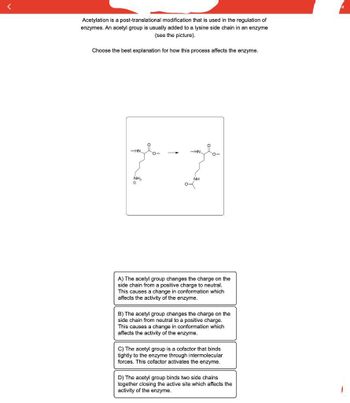
Biochemistry
9th Edition
ISBN: 9781319114671
Author: Lubert Stryer, Jeremy M. Berg, John L. Tymoczko, Gregory J. Gatto Jr.
Publisher: W. H. Freeman
expand_more
expand_more
format_list_bulleted
Question
Solve please.

Transcribed Image Text:Acetylation is a post-translational modification that is used in the regulation of
enzymes. An acetyl group is usually added to a lysine side chain in an enzyme
(see the picture).
Choose the best explanation for how this process affects the enzyme.
WHN.
NH₂
Om
1
متر
wHN.
NH
A) The acetyl group changes the charge on the
side chain from a positive charge to neutral.
This causes a change in conformation which
affects the activity of the enzyme.
B) The acetyl group changes the charge on the
side chain from neutral to a positive charge.
This causes a change in conformation which
affects the activity of the enzyme.
C) The acetyl group is a cofactor that binds
tightly to the enzyme through intermolecular
forces. This cofactor activates the enzyme.
D) The acetyl group binds two side chains
together closing the active site which affects the
activity of the enzyme.
Expert Solution
This question has been solved!
Explore an expertly crafted, step-by-step solution for a thorough understanding of key concepts.
This is a popular solution
Trending nowThis is a popular solution!
Step by stepSolved in 3 steps

Knowledge Booster
Similar questions
- Need the following questions answered please, thank you!arrow_forwardQuestion 2: lon channels are the key to cell signaling in the body. The voltage gated calcium channels discussed in question one are a part of that. These systems are in delicate balance, keeping ion concentrations around the cell at a specific level so that an electrical signal can travel, in this case, down a skeletal muscle, and cause a contraction. Both hypokalemic (too few ions) periodic paralysis and hyperkalemic (too many ions) periodic paralysis are caused by mutations to the CACNA1S gene. If a mutation created a hyperkalemic periodic paralysis phenotype, that mutation could be characterized as for the CACNA1s gene A. Gain of Function B. Loss of Function C. Null D. Silent If a mutation created a hypokalemic periodic paralysis phenotype, that mutation could be characterized as for the CACNA1s gene A. Gain of Function B. Loss of Function C. Null D. Silentarrow_forwardQUESTION 14 What switches off an activated G protein? A molecule of GDP replaces the GTP. There is an enzyme that reassembles the trimeric G protein. Ca2+ ions activate CAMKII, which inactivates the protein. The protein contains intrinsic GTPase activity which converts GTP to GDP. A phosphorylase enzyme removes the phosphate from the GTP.arrow_forward
- QUESTION 41 Which of the following statements is mismatched with the neurotransmitter? binds to muscarinic receptors - norepinephrine binds to ligand-gated ion channels - acetylcholine synthesized from tyrosine - epinephrine O released via exocytosis - dopaminearrow_forwardQUESTION 23 Which type of enzyme phosphorylates a protein? G protein protein kinase adenylyl cyclase guanosine triphosphatasearrow_forwardDear Expert. Thank you for your advice, which is good and helpful. I note that your answer is "when 3 binding sites have been occupied the activity of these receptors is maximum." However, I also note that for a similar question (see below) on α7 nicotinic Acetylcholine Receptor (nAChR) also gives the same answer, ie. at least 3 agonist binding sites should be occupied. Another Question - "To maximize the activity of an α7 nAChR, how many agonist binding sites should be occupied." I understand that in α7 nAChR, binding to two sites is more effective and binding to three sites is most effective for activation. On the other hand, binding to four or five sites in the nAChRs of chromosome 7 speeds up desensitization more than activation. Therefore, to maximize the activity of an α7 nicotinic Acetylcholine Receptor (nAChR) is also "3 sites". Am I right?arrow_forward
arrow_back_ios
arrow_forward_ios
Recommended textbooks for you
 BiochemistryBiochemistryISBN:9781319114671Author:Lubert Stryer, Jeremy M. Berg, John L. Tymoczko, Gregory J. Gatto Jr.Publisher:W. H. Freeman
BiochemistryBiochemistryISBN:9781319114671Author:Lubert Stryer, Jeremy M. Berg, John L. Tymoczko, Gregory J. Gatto Jr.Publisher:W. H. Freeman Lehninger Principles of BiochemistryBiochemistryISBN:9781464126116Author:David L. Nelson, Michael M. CoxPublisher:W. H. Freeman
Lehninger Principles of BiochemistryBiochemistryISBN:9781464126116Author:David L. Nelson, Michael M. CoxPublisher:W. H. Freeman Fundamentals of Biochemistry: Life at the Molecul...BiochemistryISBN:9781118918401Author:Donald Voet, Judith G. Voet, Charlotte W. PrattPublisher:WILEY
Fundamentals of Biochemistry: Life at the Molecul...BiochemistryISBN:9781118918401Author:Donald Voet, Judith G. Voet, Charlotte W. PrattPublisher:WILEY BiochemistryBiochemistryISBN:9781305961135Author:Mary K. Campbell, Shawn O. Farrell, Owen M. McDougalPublisher:Cengage Learning
BiochemistryBiochemistryISBN:9781305961135Author:Mary K. Campbell, Shawn O. Farrell, Owen M. McDougalPublisher:Cengage Learning BiochemistryBiochemistryISBN:9781305577206Author:Reginald H. Garrett, Charles M. GrishamPublisher:Cengage Learning
BiochemistryBiochemistryISBN:9781305577206Author:Reginald H. Garrett, Charles M. GrishamPublisher:Cengage Learning Fundamentals of General, Organic, and Biological ...BiochemistryISBN:9780134015187Author:John E. McMurry, David S. Ballantine, Carl A. Hoeger, Virginia E. PetersonPublisher:PEARSON
Fundamentals of General, Organic, and Biological ...BiochemistryISBN:9780134015187Author:John E. McMurry, David S. Ballantine, Carl A. Hoeger, Virginia E. PetersonPublisher:PEARSON

Biochemistry
Biochemistry
ISBN:9781319114671
Author:Lubert Stryer, Jeremy M. Berg, John L. Tymoczko, Gregory J. Gatto Jr.
Publisher:W. H. Freeman

Lehninger Principles of Biochemistry
Biochemistry
ISBN:9781464126116
Author:David L. Nelson, Michael M. Cox
Publisher:W. H. Freeman

Fundamentals of Biochemistry: Life at the Molecul...
Biochemistry
ISBN:9781118918401
Author:Donald Voet, Judith G. Voet, Charlotte W. Pratt
Publisher:WILEY

Biochemistry
Biochemistry
ISBN:9781305961135
Author:Mary K. Campbell, Shawn O. Farrell, Owen M. McDougal
Publisher:Cengage Learning

Biochemistry
Biochemistry
ISBN:9781305577206
Author:Reginald H. Garrett, Charles M. Grisham
Publisher:Cengage Learning

Fundamentals of General, Organic, and Biological ...
Biochemistry
ISBN:9780134015187
Author:John E. McMurry, David S. Ballantine, Carl A. Hoeger, Virginia E. Peterson
Publisher:PEARSON